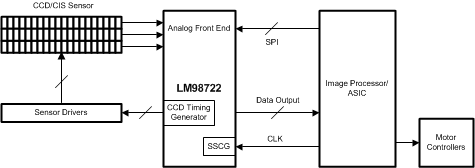SNAS487B September 2009 – March 2015 LM98722
PRODUCTION DATA.
- 1 Features
- 2 Applications
- 3 Description
- 4 Revision History
- 5 Pin Configuration and Functions
- 6 Specifications
-
7 Detailed Description
- 7.1 Overview
- 7.2 Functional Block Diagrams
- 7.3
Feature Description
- 7.3.1 Modes of Operation Introduction
- 7.3.2 Mode 3 - Three Channel Input/Synchronous Pixel Sampling
- 7.3.3 Mode 2 - Two Channel Input/Synchronous Pixel Sampling
- 7.3.4 Mode 1 - One Channel Input
- 7.3.5 CIS Lamp and Coefficient Modes
- 7.3.6 Clock Sources
- 7.3.7 Clock Sources - Additional Settings and Flexibility
- 7.3.8 Spread Spectrum Clock Generation (SSCG)
- 7.3.9 Typical EMI Cases and Recommended SSCG Settings
- 7.3.10 Recommended Master/Slave, Clock Source and SSCG Combinations and Settings
- 7.4
Device Functional Modes
- 7.4.1 Mode 3 - Three Channel Input/Synchronous Pixel Sampling
- 7.4.2 Mode 2 - Two Channel Input/Synchronous Pixel Sampling
- 7.4.3 Mode 1 - One Channel Input
- 7.4.4 Input Bias and Clamping
- 7.4.5 Sample/Hold Mode
- 7.4.6 DC Coupled Applications
- 7.4.7 Input Source Follower Buffers
- 7.4.8 CDS Mode
- 7.4.9 VCLP DAC
- 7.4.10 Gain and Offset Correction
- 7.4.11 LM98722 Typical Line Timing and Pixel Gain Regions
- 7.4.12
Automatic Black and White Level Calibration Loops
- 7.4.12.1 Calibration Overview
- 7.4.12.2 Different Modes for Different Needs
- 7.4.12.3 Calibration Initiation
- 7.4.12.4 Key Calibration Settings
- 7.4.12.5 General Black Loop Operation
- 7.4.12.6 ADAC/DDAC Convergence
- 7.4.12.7 General White Loop Operation
- 7.4.12.8 White Loop Modes
- 7.4.12.9 Bimodal (Automatic) Correction
- 7.4.13 Coarse Pixel Phase Alignment
- 7.4.14 Internal Sample Timing
- 7.4.15 CCD Timing Generator Master/Slave Modes
- 7.4.16 LVDS Control Bit Coding - LM98714 Mode
- 7.4.17 Flexible LVDS Formatting Mode: Mapping
- 7.4.18 LVDS Data Randomization for EMI Reduction
- 7.4.19 LVDS Drive Strength Adjust
- 7.4.20 LVDS Output Timing Details
- 7.4.21 LVDS Data Latency Diagrams
- 7.4.22 Data Test Patterns
- 7.4.23 CMOS Output Format
- 7.4.24 CMOS Output Data Latency Diagrams
- 7.4.25 Serial Interface
- 7.5 Registers Maps
- 8 Layout
- 9 Device and Documentation Support
- 10Mechanical, Packaging, and Orderable Information
1 Features
- LVDS/CMOS Outputs
- LVDS/CMOS/Crystal Clock Source with PLL Multiplication
- Integrated Flexible Spread Spectrum Clock Generation
- CDS or S/H Processing for CCD or CIS sensors
- Independent Gain/Offset Correction for Each Channel
- Automatic per-Channel Gain and Offset Calibration
- Programmable Input Clamp Voltage
- Flexible CCD/CIS Sensor Timing Generator
2 Applications
- Multi-Function Peripherals
- High-speed Currency/Check Scanners
- Flatbed or Handheld Color Scanners
- High-speed Document Scanners
-
Key Specifications:
- Maximum Input Level:
- 1.2-V or 2.4-V Modes (Both with + or - Polarity Option)
- ADC Resolution: 16-Bit
- ADC Sampling Rate: 45 MSPS
- INL: +18/-25 LSB (typ)
- Channel Sampling Rate: 22.5/22.5/15 MSPS (1ch/2ch/3ch)
- PGA Gain Steps: 256 Steps
- PGA Gain Range: 0.64 to 8.3x
- Analog DAC Resolution: +/-9 Bits
- Analog DAC Range: +/-307 mV or +/-614 mV
- Digital DAC Resolution: +/-6 Bits
- Digital DAC Range: -2048 LSB to + 2016 LSB
- SNR: -74dB (at 0dB PGA Gain)
- Power Dissipation: 630 mW (LVDS)
- Operating Temp: 0 to 70°C
- Supply Voltage: 3.3-V Nominal (3.0-V to 3.6-V Range)
- Maximum Input Level:
3 Description
The LM98722 is a fully integrated, high performance 16-Bit, 45 MSPS signal processing solution for digital color copiers, scanners, and other image processing applications. High-speed signal throughput is achieved with an innovative architecture utilizing Correlated Double Sampling (CDS), typically employed with CCD arrays, or Sample and Hold (S/H) inputs (for higher speed CCD or CMOS image sensors). The signal paths utilize 8 bit Programmable Gain Amplifiers (PGA), a +/-9-Bit offset correction DAC and independently controlled Digital Black Level correction loops for each input. The PGA and offset DAC are programmed independently allowing unique values of gain and offset for each of the three analog inputs. The signals are then routed to a 45-MHz high performance analog-to-digital converter (ADC). The fully differential processing channel shows exceptional noise immunity, having a very low noise floor of -74dB. The 16-bit ADC has excellent dynamic performance making the LM98722 transparent in the image reproduction chain.
A very flexible integrated Spread Spectrum Clock Generation (SSCG) modulator is included to assist with EM compliance and reduce system costs.
Device Information
| ORDER NUMBER | PACKAGE | BODY SIZE |
|---|---|---|
| LM98722 | TSSOP (56) | 14.0 mm x 6.10 mm |
Simplified Schematic

4 Revision History
Changes from A Revision (April 2013) to B Revision
- Added, updated, or revised the following sections in accordance with new datasheet standards: Description; Pin Configuration and Functions; Specifications; Detailed Description; Application and Implementation; Device and Documentation Support; and Mechanical, Packaging, and Ordering InformationGo
- Changed "29" to "33" for Pin 32 INCLK+ in Pin Functions tableGo
- Deleted "Boldface limits apply..." statement in Electrical Characteristics and AC Timing RequirementsGo
- Changed "external" to "internal" and changed "internal" to "external" under "SH_R Capture Clock Select (Page 0, Register 0x00, Bit 5)" bullet point in Clock Sources - Additional Settings and FlexibilityGo
- Changed 25 MHz to 15 MHz in Table 4Go
- Changed 50 MHz to 45 MHz in Table 4Go
- Changed "Page 2" to "Page 0" in CCD Timing Generator Master/Slave Modes and Master Timing Generator ModeGo
- Added "Note" to Serial InterfaceGo
- Changed "1100 0000" to "1100 0010" for Page 0, Addr 2 Go
Changes from * Revision (April 2013) to A Revision
- Changed layout of National Data Sheet to TI formatGo